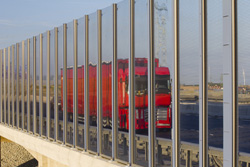Blocking sound propagation more effectively
One of the targets of the European Commission's Environmental Noise Directive (END) is to reduce the overall number of people exposed to transport noise. Noise-reducing devices (NRDs) such as barriers, claddings and covers designed to minimise sound propagation are an important pillar of EU noise reduction research. Depending on a number of factors, the performance of NRDs can vary drastically. Optimising their effectiveness is an important part of any sustainable surface transport policy. Numerous studies have addressed product optimisation or in situ performance optimisation but few have addressed both simultaneously. For the first time, EU-funded scientists working on the project 'Quietening the environment for a sustainable surface transport' (QUIESST) studied both intrinsic and extrinsic product characteristics. Their aim was to enhance the capacity of NRDs and reduce the number of people exposed to noise from both road and rail transport. Researchers investigated the link between the intrinsic properties of an NRD and their effect on noise propagation at a distance (near/far field relationship). They employed a variety of in situ measurement techniques to assess sound absorption/reflection and airborne sound insulation for long-term performance control. Investigators developed the first comprehensive EU database containing existing and new test results on NRDs together with associated optimisation models. After characterising the issues, scientists optimised NRD global performance by considering multiple performance criteria, including non-acoustic and acoustic characteristics. The study would not be complete without the first overall sustainability assessment regarding NRDs for a truly holistic approach to surface transport noise reduction. Project outcomes are showcased in a comprehensive reference guidebook about NRD holistic optimisation that includes reference to associated databases, simulation techniques, measurement methodologies and recommendations. QUIESST successfully addressed the issue of sound propagation and optimised NRDs to minimise the number of people exposed to noise from road and rail transport. The guidebook detailing measurement and modelling techniques, optimisation methods and recommendations promises to have major impact on the quality of life of EU citizens.







